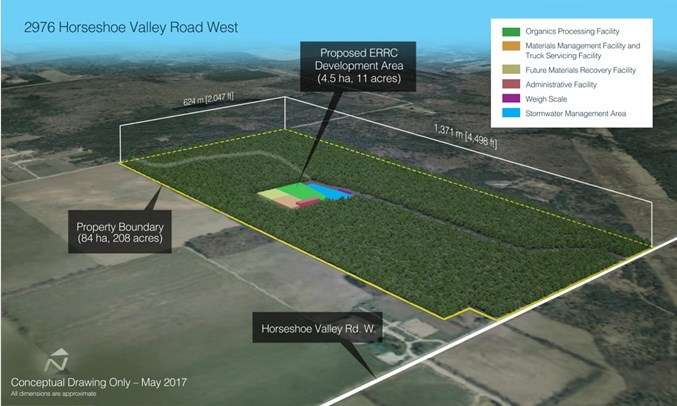The Environmental Resource Recovery Centre (ERRC) has been a contentious issue around the Simcoe County council table for years.
The project has been in the preparation stage for a long time; it was first proposed back in 2010.
However, now that the zoning bylaw amendment was approved by county council on Tuesday and is off to the province, the county is turning its attention to the newest and most exciting technologies available.
“In the waste world, utilizing bio gas from organics is where it’s at right now. There’s a lot of interest,” says Stephanie Mack, the county's special projects supervisor.
There are two major components of the proposed ERRC at 2976 Horseshoe Valley Rd., in Springwater Township.
The first component is a material management facility (MMF), where waste from multiple collection vehicles is consolidated and transferred allowing for cost-effective shipment to other locations.
The second component is an organics processing facility (OPF), where green-bin materials are brought, broken down and converted into resources such as compost, fertilizer or fuel.
The county says the initial cost estimate for the MMF is $15 million, while the OPF will be between $16 million and $35 million, depending on which technology they choose to employ.
There are three main types of technology the county could choose to invest in for the OPF which were presented to county council in a preliminary business case in September 2017: composting, liquid anaerobic digestion and solid anaerobic digestion.
Composting is when microorganisms, including bacteria and fungi, break down organic matter into an organic fertilizer.
Liquid anaerobic digestion (the technology of choice in Ontario for the last three or four years), is when items are sorted out of the green bin, liquefied and put it in tanks without oxygen. The byproduct is heat and methane, which can then be collected, cleaned up and put into natural gas pipelines or can be burned to generate electricity. Gas and electricity can then be sold.
Solid anaerobic digestion is the same process as liquid anaerobic digestion -- but not turned into a liquid -- and the result is renewable natural gas.
In a recent interview with Village Media, Rob McCullough, director of solid waste management for Simcoe County, referenced the solid anaerobic digestion being done at organics facilities in Surrey, B.C. As they are well into their program, they are at a point where they can inject the renewable natural gas into their pipelines to fuel their natural gas fleet of garbage collector trucks.
“It’s a real circular economy... it’s quite exciting,” says McCullough. “While we’re not the first, we hope to be among the leaders.”
Lower cost technologies have higher operating costs and vice versa, all of which will be taken into consideration. If the county opts to choose the higher cost technology right off the bat, the cost is taking 20 or 30 years of operation into consideration since the long-term operating costs will be much lower.
“We won’t know for certain what all the prices are until we do a proper request for proposals,” said McCullough.
Assuming the approvals are in place, work is slated to begin on the site in 2019, commissioning the MMF in 2021 and the OPF in 2024.
For more information on the ERRC project, click here.



